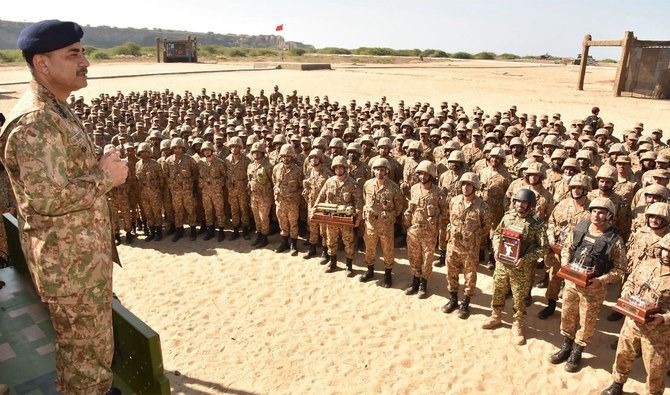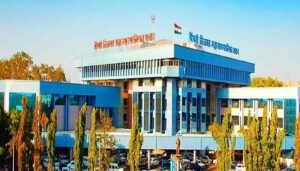AS PAKISTAN LAUNCHES OPERATION AZM-I-ISTEHKAM IT NEEDS TO ADDRESS ITS FUNDAMENTAL CONFUSION

By Maj Gen Jagatbir Singh, VSM (Retd)
New Delhi, 4th July 2024: On 02 July a former Senator Hidayatullah Khan was killed, along with four others, in a blast from an improvised explosive device (IED) in Khyber Pakhtunkhwa’s Bajaur. This is the latest amongst a increasing number of Incidents in Pakistan.
On 22 June, Pakistan announced that it is launching a counterterrorism (CT) campaign which promises to eradicate all forms of extremism and violent militancy in the country in a “decisive manner,” which Pakistan blames on the banned Tehreek-i-Taliban Pakistan (TTP) leadership hiding in Afghanistan,
Described as an attempt to “reinvigorate and re-energise the ongoing implementation of the Revised National Action Plan, “Operation Azm-i-Istehkam” which means Strong Commitment for Stability” or “Strong Resolve for Stability” is the latest in a list of kinetic actions that Pakistan’s security forces have undertaken over the last two decades.
Despite earlier operations, the menace of terrorism has persisted in presenting a challenge to Pakistan’s security. This has raised questions about its strategy in dealing with a threat which ‘is of its own creation’.
Earlier Operations
It was in 2001 that the military-led government of Gen Pervez Musharraf launched the so-called Operation Enduring Freedom in the former tribal regions following the US invasion of Afghanistan. A series of CT campaigns followed: Al-Mizan (2002), Zalzala (2008) Sher Dil, Rah-i-Haq, and Rah-i-Raast (2007-2009), Rah-i-Nijaat (2009), Zarb-i-Azb (2014) and Raddul Fasaad (2017).
Given the questionable success of the previous operations, there is scepticism over the launch of the present operation. This is also because Pakistan is seen to be making compromises with militant outfits it claims to be fighting, hence there exists a trust deficit between the state and the people on this count. An example of this was the secret deal with the TTP in 2022, which allowed thousands of armed militants to return home and regroup.
Despite various military operations, the menace of terrorism has returned with greater ferocity. The militants, are better organised and equipped with sophisticated weaponry, are now involved in attacks that are taking a huge toll, especially on the security forces. As per the annual security report of the Centre for Research and Security Studies, Pakistan “witnessed 1,524 violence-related fatalities and 1,463 injuries from 789 terror attacks and [CT] operations in 2023 — marking a record six-year high”. Matters turned worse in the first half of 2024 with a rise in militant activities, particularly in KP and Balochistan.
There has been an exponential rise in terrorism in Pakistan since the Taliban returned to rule Afghanistan in 2022. There are reports of tacit Afghan Taliban support for the TTP. Pakistan in turn has blamed the Taliban administration in Kabul for not taking action against TTP sanctuaries on its soil.
The Inter-Services Public Relations, the military’s media wing, has stated that the “recent wave of terrorism in Pakistan has the full support and assistance of Afghanistan”. “The Afghan interim government is not only arming the terrorists but also providing a safe haven for other terrorist organisations as well as being involved in the incidents of terrorism in Pakistan”.
The Pakistan Foreign Office has said that terror outfits, including the TTP, “pose a grave threat to Pakistan’s security and have consistently used Afghan territory to launch terror attacks inside Pakistani territory”.
Attacks on Chinese Citizens
The targeted attacks against Chinese nationals working on various development projects in the country has caused concern in China. The latest attack took place a few months ago, when a suicide bomber rammed his explosives-laden vehicle into a convoy in a remote District in KP where a key dam is being constructed. As a result, five Chinese workers were killed.
This was the third major attack this year on Chinese interests in the country. The growing number of targeted killings of Chinese nationals also has serious geopolitical implications. Thousands of Chinese workers are engaged in multibillion-dollar infrastructure projects in the country under the CPEC China, and China has invested $62bn in the project .
The increasing occurrence of targeted killings of Chinese nationals has in turn raised questions about Pakistan’s ability to ensure the security of its citizens and was brought up when Prime Minister Shehbaz Sharif visited China recently. It is apparent that the launching of a new CT operation has been largely driven by the threat of Chinese Companies pulling out their investment from Pakistan.
Liu Jianchao a Chinese official who visited Pakistan last week, reiterated the importance of protecting Chinese interests in the country. “We need to improve security and the business environment. In Pakistan’s case, the primary factor shaking the confidence of Chinese investors is the security situation.”
Challenges in Dealing with Terrorism
The issue of terrorism is a complicated one, which involves crime, drugs, smuggling, extremism and religiously motivated militancy. But there seems to be no coherent policy in place to deal with the challenge, and thus successfully counter the extremist narrative.
While the latest bout of terrorism in Pakistan needs to be responded militarily, there are questions regarding the limits of kinetic force to quell the threat. No doubt, the state must employ force where necessary. But this is not very effective unless accompanied by non-kinetic measures. The threat posed by violent extremism cannot be countered without broad political support.
Analysts have said that despite the government’s claim of removing the shortcomings in the implementation of National Action Plan (NAP), there are no signs that the administration is carrying out long-delayed reforms critical for containing extremism in the country.
What is also not clear is if the operations will be intelligence-based operations (as in the recent past) rather than full-scale operations. The environment in 2008 was very different when large-scale operations were launched. At that time, the TTP was in control of territory and the operations were launched, to dislodge the militants and impose the ‘writ of the state’. As per reports in the media it seems that TTP is not controlling territory in the same way.
That time operations were partly based on assumptions that once the TTP fighters tried to escape the military operations by crossing the border, they would be confronted by Afghan and NATO forces. However, this time around, give the relations with Afghanistan operations will be difficult, as the regime in Kabul is unlikely to provide assistance in eliminating the TTP.
Also, the large-scale operations earlier enjoyed widespread public support; the latter didn’t just come from the urban centres and the mainstream areas of the country but also political parties based in KP. However, this time around, this support will not be easy to ensure because the people are openly hostile to operations.
The mass-scale displacement of people, the challenges of living in refugee camps, and then their return to homes and livelihoods destroyed by war and delayed compensations, has made the Pakhtun population wary. This has been brought home by the mass protests that were held in many areas when the TTP reappeared in 2022. The large gatherings in a number of areas, including Swat, were not simply against the TTP but also against military action; such is the public mood that all parties took a stand against them.
This distrust of the state and its institutions will not make it easy to create public support for widespread use of state force, as in the past.
Finally, there is also the issue of expense. The extensive military operations in the past took place at a time when aid from the US in the form of coalition support funds was still making its way to Pakistan. At present, with no such aid and the cash crunch the country is dealing with, any planning for military operations will also have to consider how they will be financed.
While speaking at the Wilson Centre, Pakistan’s Ambassador to the US Masood Khan has urged the US to provide small arms and modern communication equipment to ensure the success of Operation Azm-i-Istehkam. He also emphasised that Pakistan and the US should maintain strong security links, enhance intelligence cooperation, resume sales of advanced military platforms, and work on “the sustainment of US-origin defence equipment”.
Can Afghanistan Be Targeted
Pakistan’s Defence Minister Khawaja Asif has recently hinted at the possibility of cross-border strikes to eliminate militant hideouts in Afghanistan. In an interview with Voice of America, the Defence Minister said Islamabad could strike terror havens in Afghanistan and it would not be against international law since Kabul had been “exporting” terrorism to Pakistan and the “exporters” were being harboured there. He said though the TTP was operating from the neighbouring country, its cadre, about a few thousand in number, “are operating from within the country” and blamed the PTI government for bringing these militants back.
In separate remarks to Geo News, the he said Islamabad would “stringently enforce international laws at its borders with Afghanistan” to restrict the movement of smuggled goods. “All traffic from Afghanistan will only be allowed entry into Pakistan with a valid passport and visa”.
His statement came on the same day as Maulana Fazlur Rehman’s warning about the critical security situation in Khyber Pakhtunkhwa. The JUI-F Chief said that things had reached a point where even the police could not go out at night due to the presence of armed men. He said that armed men control traffic, set up roadblocks and collect tolls from motorists. Besides, he said that police across the Southern Districts of KP find themselves besieged in police stations after dusk. “They are not allowed to perform their duties outside the police station during night”.
However, the Maulana compared Afghanistan to Iran. Issues with Iran were resolved within a week of both countries conducting strikes inside each other’s territories, he said, asking why Afghanistan was not being dealt with in the same manner.
While addressing a press conference after a grand tribal jirga, he said Islamabad was making its decision about Kabul based on anger and emotions, adding that issues between states could not be resolved in haste or through threats as it would only result in further deterioration of bilateral relations. “When people questioned establishment over law-and-order situation, they simply shift the blame to Afghanistan,” he claimed.
According to the Maulana, “The jirga expressed its lack of trust in the operation and declared that this was not Azm-i-Istehkam, rather Adam-i-Istehkam (instability).”
Conclusion
The attacks in Pakistan have exposed its vulnerabilities as well as the increasing political and economic instability in the country, particularly in KP, which has borne the brunt of the terrorist resurgence. There now appears to be a severe breakdown of law enforcement in this region as the confrontation between the centre and the provincial government worsens.
Given their past record and intimate relationship with terrorism there however remains skepticism regarding the success of these operations. For Pakistan there cannot be two sets of rules to deal with terror targeting those in its West and nurturing those on its East. It needs to address this fundamental confusion.
The real problem is that how long and how often can the Pakistani military continue this bluff of shadow boxing with the TTP and other terror organisations that they have links with. Conviction and money to successfully execute these operations is therefore questionable and likely to remain an illusion.








